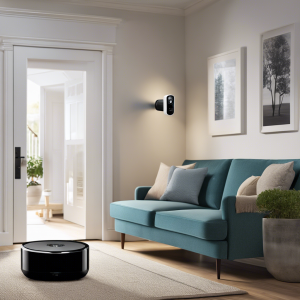In today’s technologically advanced world, ensuring the safety and security of our homes has become a top priority. With the rise of wireless technology, homeowners now have access to a wide range of options when it comes to protecting their properties.
From smart cameras and motion sensors to alarm systems and video doorbells, the choices seem endless. But which wireless home security options are truly the best?

In this discussion, we will explore some of the top contenders in the market, highlighting their features, benefits, and potential drawbacks.
So, if you’re looking to enhance the security of your home, stay tuned to discover the best wireless options available.
Smart Cameras
Smart cameras offer advanced security features and real-time monitoring capabilities for wireless home security systems. These high-tech devices have revolutionized the way we protect our homes, providing homeowners with a greater sense of security and peace of mind.
One of the key benefits of smart cameras is their ability to integrate with other smart devices, such as smart locks and home automation systems. This integration allows homeowners to create a comprehensive security ecosystem that can be controlled and monitored remotely.
Smart cameras are equipped with motion detection technology, enabling them to automatically start recording when movement is detected. This feature ensures that any suspicious activity is captured and stored for future reference. Additionally, some smart cameras have facial recognition capabilities, allowing homeowners to receive alerts when unfamiliar individuals are detected on their property.
Real-time monitoring is another standout feature of smart cameras. Homeowners can view live video feeds from their cameras using their smartphones or computers, giving them the ability to keep an eye on their property at all times. This feature is particularly useful for those who travel frequently or have multiple properties to monitor.
Motion Sensors
As we move on to exploring motion sensors, another integral component of wireless home security systems, we delve into the technology that plays a crucial role in detecting and alerting homeowners of any movement within their property. Wireless motion sensors are designed to detect motion and trigger an alarm or notification when movement is detected. These sensors use various technologies, such as infrared, microwave, or dual technology, to accurately detect motion.
When considering wireless motion sensors for your home security system, it is important to understand the different types available. Passive Infrared (PIR) sensors are the most common and affordable option. They detect changes in infrared radiation, such as body heat, and are ideal for indoor use. Microwave sensors, on the other hand, emit microwave pulses and measure the reflection to detect motion.
These sensors are more suited for outdoor use as they are less affected by environmental conditions. Dual technology sensors combine both PIR and microwave technologies for enhanced accuracy and reduced false alarms.
When choosing motion sensors for your wireless home security system, consider the specific requirements of your property. Factors such as the size of the area to be covered, environmental conditions, and the presence of pets or other potential sources of false alarms should be taken into account.
Alarm Systems
Alarm systems play a vital role in wireless home security, providing an effective deterrent against potential intruders and alerting homeowners of any unauthorized access or potential threats.
One important component of an alarm system is the wireless keypad, which allows homeowners to arm or disarm the system from a convenient location within their home. The wireless keypad eliminates the need for complex wiring, making installation quick and easy.
Additionally, many alarm systems now offer a security app that allows homeowners to control and monitor their system remotely. With the security app, homeowners can receive real-time notifications on their smartphones or tablets regarding any security breaches or suspicious activities in their homes. They can also check on the status of their alarm system, view live video feeds from security cameras, and even remotely lock or unlock doors. This added convenience and flexibility ensures that homeowners can keep a close eye on their home’s security, even when they are away.
Door and Window Sensors
Door and window sensors are essential components of a wireless home security system, providing an additional layer of protection against unauthorized access. These sensors are designed to detect when a door or window is opened or closed, triggering an alert or activating the alarm system.
The installation process for door and window sensors involves placing a sensor on the frame of the door or window and a magnet on the corresponding moving part. When the door or window is closed, the magnet aligns with the sensor, completing the circuit.
If the door or window is opened, the magnet moves away from the sensor, breaking the circuit and triggering the alarm.
There are different types of door and window sensors available in the market. The most common type is the magnetic sensor, which uses magnets to detect movement. There are also acoustic sensors that use sound waves to detect vibrations caused by a forced entry.
Another type is the glass break sensor, which can detect the sound frequency of breaking glass and trigger the alarm. Some door and window sensors are also equipped with additional features like temperature and humidity sensors, allowing homeowners to monitor environmental conditions.
Video Doorbells
Video doorbells have become increasingly popular in recent years as a convenient and effective way to enhance home security. These devices serve as a modern-day peephole, allowing homeowners to see and communicate with visitors at their front door, even when they are not at home.
With advancements in technology, video doorbells now come equipped with features such as motion detection, night vision, and high-definition video recording. This allows homeowners to monitor their front porch and receive instant alerts on their smartphones whenever someone approaches their door.
One of the key benefits of video doorbells is their integration with smart locks and home automation systems. By connecting the video doorbell to a smart lock, homeowners can remotely unlock their doors to allow trusted individuals access to their homes. This feature is particularly useful for deliveries or granting access to family members, friends, or service providers.
Furthermore, video doorbells offer an added layer of security by deterring potential burglars. The presence of a visible camera at the front door can discourage criminals from attempting a break-in, as they know their actions are being recorded.
Frequently Asked Questions
Can Smart Cameras Be Used Indoors and Outdoors?
Smart cameras can be used both indoors and outdoors, providing homeowners with enhanced security and peace of mind. With features like motion detection and remote access, these cameras offer benefits in monitoring and deterring potential intruders in any setting.
Do Motion Sensors Work in the Dark?
Motion sensors are an essential component of wireless home security systems. They are designed to detect movement within a specified range, even in low-light or dark conditions. The benefits of using motion sensors include enhanced security and the ability to trigger alarms or notifications.
Can Alarm Systems Be Easily Integrated With Other Smart Home Devices?
Alarm systems can be easily integrated with other smart home devices, providing seamless compatibility and enhanced security. This integration capability allows homeowners to control and monitor their alarm systems through their existing smart home platforms, creating a comprehensive and convenient home security solution.
How Many Door and Window Sensors Are Usually Included in a Standard Package?
The number of door and window sensors included in a standard wireless home security package can vary, depending on the specific provider. The installation process typically involves placing the sensors on doors and windows and connecting them to the central control panel.
Can Video Doorbells Record and Save Footage for Later Viewing?
Video doorbells are equipped with features that allow them to record and save footage for later viewing. This provides homeowners with the benefit of being able to review any suspicious activity or incidents that occurred at their front door.
When it comes to choosing the best wireless home security options, smart cameras, motion sensors, alarm systems, door and window sensors, and video doorbells are all reliable choices.
These devices provide enhanced security and convenience for homeowners, allowing them to monitor their property and receive alerts in real time.
By investing in these wireless home security solutions, individuals can have peace of mind knowing that their homes are well-protected.



